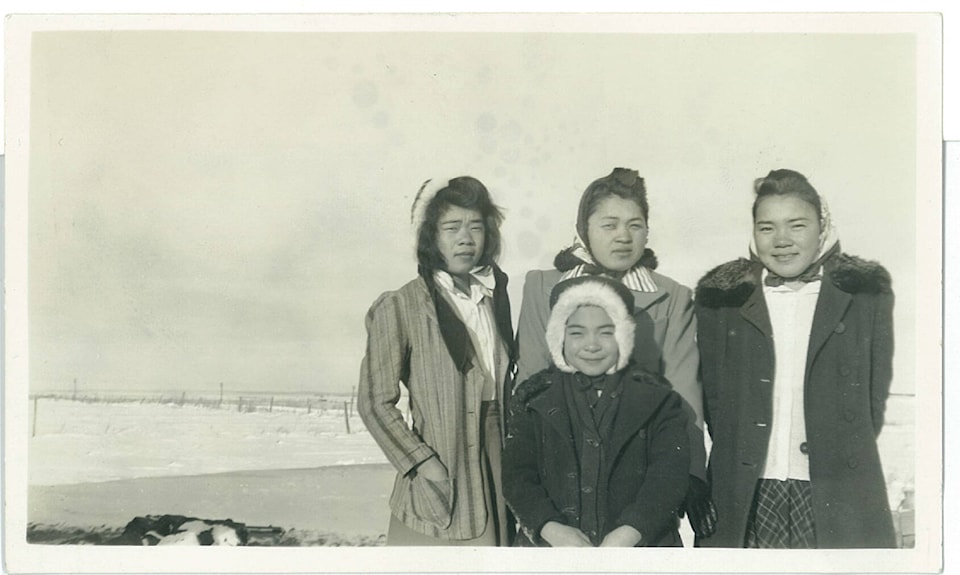A collection of photos and letters written to a Surrey high school student during the Second World War is now available to view as an online interactive exhibit.
The collection of letters and photographs were between Joan Parolin (née Gillis) and some of her classmates from Queen Elizabeth Secondary, who were part of the forced dispersal of Japanese Canadian to internment camps.
After Japan attacked Pearl Harbor on Dec. 7, 1941, Canada declared war on the country. The following year, approximately 22,000 Japanese-Canadians in B.C. were forced into internment camps.
In 2018, Parolin donated the collection of 149 letters and 10 small photographs to the UBC Library. In the years since, the UBC library has worked to connect with the descendants of the letter writers, and students last summer worked to create an online exhibit.
Sasha Gaylie and Mya Ballin spent last summer creating the online exhibit, “I Know We’ll Meet Again,” which officially launched March 1.
“One of the things that was both great and challenging about the experience was that we had to complete it in such a short time,” explained Ballin, who is a Master of Library and Information Studies (MLIS) and Master of Archival Studies student at UBC.
She said while the professional experience is often half a year, corresponding with the academic terms, Ballin said she and Gaylie had a shorter turnaround.
“We had to get really invested and really up to date, both with the content of the letters, but also with what we wanted to do with them,” she said. “Because we had been so invested, we really felt like we had sort of been able to meet the letter writers.”
Part of that, Ballin said, is what Parolin meant to the letter writers.
Parolin, who attended Queen Elizabeth Secondary during the Second World War, wrote to 13 Japanese Canadians after they were sent to internment camps.
While some were her former classmates, others she got to know just through writing letters.
“There are some hints of it through the letters, but it was also communicated to us that some of them didn’t actually know her necessarily very well when they were living in B.C.,” Ballin said. “It was really interesting to think about the fact that in addition to potentially being close friends, she also just represented someone that you could write too.”
But for those who knew Parolin from school, and even though they only had letters written to Parolin, Gaylie said “there were hints there of what kind of friend she was and what she meant to these correspondents.”
“There’s this one kind of multi-letter arc with one of the writers, with Yoshio (Nakamura), where he’s asking Joan for this school pin from the Queen Elizabeth high school they attended together,” explained Gaylie, also an MLIS student.
“At first you think, he just wants this souvenir from back home and it sounded like Joan couldn’t get it for him. This went on in multiple letters. He would say, ‘P.S. could you please look into getting me this pin?’ We were guessing that Joan must have been saying ‘Oh, I tried but I couldn’t,’” said Gaylie.
“So you think it’s done and finally one of the later letters he says in this little paragraph ‘Joan, I can’t tell you enough how happy I am that you managed to find this pin for me.’ He draws the exact link between this pin being this representation of his memories from back home when they were together and just kids going into school and you realize how significant this pin is for him.”
That connection to Queen Elizabeth Secondary was “a thread that goes across so many of the letters,” Gaylie said.
“I can’t even remember how many letters start with How’s QE, how’s ‘X’ teacher or ‘X’ student doing?”
The online exhibit can be found at ubc-library-rbsc.github.io/gillis-2021.
It was last fall that Tomoko Kitayama Yen, a Japanese studies librarian, and Krisztina Laszlo, archivist for rare books and special collections, had been trying to connect with the family members of those who wrote to Joan Parolin (née Gillis) while in internment camps in northern B.C. and the Prairies.
When the Now-Leader spoke with Kitayama Yen and Laszlo last fall for the story they had so far been able to make contact with families of nine of 13 letter writers.
READ ALSO: Wartime letters between Surrey teen and interned Japanese friends spark search for descendants, Sept. 17, 2021
At that time, they were still looking for families of Akira Fujii, Emee Otsuki, Leo Otsuki and Masao Ujiiye.
Kitayama Yen said since then – and thanks to some amazing help from Now-Leader readers – they were able to trace family members for all four of them and she was able to correspond with family members of Akira, Emee and Leo.
Sadly, she said, another reader was able to find a death notice for Masao, who died in 1959 while living in Delta. The death notice says he had several nieces and nephews, but Kitayama Yen said they haven’t been able to locate his family.
lauren.collins@surreynowleader.com
Like us on Facebook Follow us on Instagram and follow Lauren on Twitter
